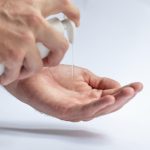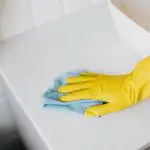Are you tired of grappling with the age-old question of which adhesive is superior for fabrics: Loctite or super glue? Look no further, as we delve into the intricacies of these two remarkable adhesives.
You'll gain a comprehensive understanding of their composition, strength, application, drying time, flexibility, durability, washability, color transparency, safety considerations, and cost.
By the end, you'll be equipped with the knowledge to make an informed decision about which adhesive is the perfect match for your fabric projects.
Let's embark on this journey to unravel the mystery of choosing the ideal adhesive for fabrics.
Key Takeaways
- Loctite is composed of acrylic, while Super Glue is made of cyanoacrylate.
- Loctite is suitable for heavy-duty fabric applications, while Super Glue is particularly effective on porous fabrics.
- Loctite has a faster drying time compared to Super Glue.
- Loctite provides a more flexible bond and better color fastness, while Super Glue may result in stiffness and color loss.
Composition and Strength
When considering the composition and strength of adhesives for fabrics, you should prioritize a product's ability to withstand tension and provide durable bonding. In the realm of fabric adhesives, the chemical composition plays a crucial role in determining the strength and durability of the bond.
Loctite and Super Glue are two prominent options for fabric adhesion, and a strength comparison between the two reveals interesting insights.
The chemical composition of Loctite primarily consists of acrylic, while Super Glue is composed of cyanoacrylate. Both adhesives have their strengths, with Loctite being known for its ability to withstand tension and resist impact, making it suitable for heavy-duty fabric applications. On the other hand, Super Glue is revered for its fast-acting and strong bonding capabilities, particularly on porous fabrics.
Understanding the chemical composition of these adhesives provides a foundation for comprehending their respective strengths and areas of application in fabric bonding.
Application and Drying Time
For fabric adhesives like Loctite and Super Glue, the application method and drying time are crucial aspects to consider for achieving optimal bonding results. Proper application and adequate drying time ensure a strong and durable bond between fabric materials. Here's what you need to know about the application and drying time of these fabric adhesives:
- Application Technique:
When using Loctite or Super Glue on fabric, ensure that the surface is clean and free from any dirt or residue. Apply a thin, even layer of adhesive to one of the fabric surfaces. Press the two fabric pieces firmly together, ensuring that the adhesive spreads evenly and makes full contact with both surfaces.
- Drying Time:
Loctite generally has a faster drying time compared to Super Glue. It typically sets within 5-15 minutes, depending on the specific product. Super Glue, on the other hand, may take slightly longer to dry, usually within 10-30 minutes.
- Curing Time:
While both adhesives may dry within the specified time, allowing them to cure for 24 hours ensures maximum bond strength.
- Avoid Disturbance:
After application, refrain from disturbing the bonded fabric surfaces until the adhesive has completely dried and cured to prevent any weakening of the bond.
Understanding the application technique and drying time of these fabric adhesives is essential for achieving the best results in fabric bonding.
Flexibility and Durability
To assess the flexibility and durability of fabric adhesives, consider the adhesive's ability to withstand various stresses and maintain its bond over time. When comparing Loctite and Super Glue for fabrics, flexibility is a crucial factor to consider.
While Super Glue provides a strong bond, it can result in stiffness, which may not be ideal for fabrics that require flexibility. On the other hand, Loctite offers a more flexible bond, allowing the fabric to move and stretch without compromising the adhesive's strength. This flexibility vs stiffness comparison is essential when choosing the right adhesive for your fabric projects, especially those involving clothing or accessories.
In terms of longevity and wear resistance, both Loctite and Super Glue exhibit impressive durability. They can withstand regular wear and tear, as well as washing and drying processes. However, Loctite's formula is specifically designed to endure the rigors of fabric applications, making it an excellent choice for long-lasting bonds.
Its ability to maintain adhesion over time, even with frequent use, sets it apart in terms of longevity and wear resistance. When considering the durability of fabric adhesives, Loctite's resilience makes it a top contender for fabric bonding needs.
Washability and Color Transparency
When considering the washability and color transparency of adhesives for fabrics, it's crucial to examine the retention of colors and the ability to resist stains. You'll want to assess the differences in stain resistance and determine which adhesive provides long-term durability for your fabric projects.
Color Retention Comparison
When comparing the color retention of fabrics bonded with Loctite versus Super Glue, you'll notice differences in washability and color transparency. Here's what to consider:
- Color Fastness: Fabrics bonded with Loctite generally exhibit better color fastness, meaning the colors are less likely to fade or bleed during washing compared to those bonded with Super Glue.
- Fabric Compatibility: Loctite is designed to be compatible with a wider range of fabrics, ensuring that the bonded fabrics maintain their original color vibrancy and integrity.
- Washability: Fabrics bonded with Loctite are often more washable, retaining their original colors even after multiple wash cycles, while those bonded with Super Glue may experience color loss or transparency.
- Color Transparency: Fabrics bonded with Super Glue may exhibit more color transparency, especially after washes, compared to those bonded with Loctite, which tend to maintain their original color opacity.
Stain Resistance Differences
If you want to understand the differences in stain resistance between Loctite and Super Glue for fabrics, consider their washability and color transparency.
When it comes to washability, Loctite offers better resistance to stains and is more compatible with various fabric types. Its bonding effectiveness ensures that the fabric's integrity remains intact even after washing.
On the other hand, Super Glue's stain resistance may vary depending on the fabric type and the specific formulation of the glue.
Additionally, Loctite tends to have better color transparency, meaning it's less likely to leave noticeable marks on the fabric after application. This is crucial for maintaining the aesthetic appeal of the fabric.
When choosing between the two, considering the fabric compatibility and bonding effectiveness will help you make an informed decision.
Long-Term Durability Assessment
For a thorough evaluation of long-term durability, assess the washability and color transparency of both Loctite and Super Glue for fabrics. When comparing the two adhesive options, consider the following factors:
- Durability Comparison: Examine how well each adhesive holds up after multiple wash cycles. Look for any signs of weakening or deterioration in bond strength.
- Fabric Compatibility: Test the adhesives on a variety of fabric types to determine their compatibility and effectiveness across different materials.
- Color Transparency: Evaluate how the adhesives affect the transparency of the fabric, particularly when dealing with light or delicate colors.
- Stain Resistance: Assess how resistant the adhesives are to staining and discoloration over time, especially when exposed to various liquids and environmental factors.
Ensure that the long-term durability assessment covers these key aspects to make an informed decision on the most suitable adhesive for fabric applications.
Safety and Health Considerations
When using adhesives on fabrics, it's crucial to consider the safety and health implications.
Chemical fume exposure, potential skin irritation, and allergen sensitivity are key points to be aware of.
Understanding these considerations will help you make informed decisions about which adhesive to use for your fabric projects.
Chemical Fume Exposure
Ensure you ventilate the area to minimize exposure to chemical fumes when using either Loctite or Super Glue for fabrics. Chemical fume exposure can pose health risks, so it's essential to take precautions.
Here are some key considerations for minimizing chemical fume exposure:
- Ventilation: Use in a well-ventilated area or consider using a fume hood to minimize exposure to fumes.
- Protective Equipment: Wear gloves and a mask to avoid direct contact with the fumes and prevent inhalation.
- Avoid Skin Contact: Minimize skin exposure to the adhesives to prevent any potential skin irritation or allergic reactions.
- Storage: Store the adhesives in airtight containers and in a well-ventilated area to prevent the buildup of potentially harmful fumes.
Taking these precautions will help ensure your safety when working with adhesives.
Skin Irritation Potential
To minimize skin irritation potential when using either Loctite or Super Glue for fabrics, wear protective gloves and a mask to prevent direct contact with the adhesives and inhalation of fumes. Skin sensitivity to adhesives varies among individuals, and prolonged or repeated exposure to these chemicals can lead to skin irritation.
Both Loctite and Super Glue contain cyanoacrylate, which can cause skin irritation or allergic reactions in some people. It's essential to be cautious and attentive to any signs of skin irritation when using these adhesives. If you experience any adverse reactions, such as redness, itching, or swelling, discontinue use immediately and seek medical advice.
Prioritize safety by minimizing chemical exposure to the skin through the use of protective gear and proper ventilation when working with these adhesives.
Allergen Sensitivity Risk
To minimize allergen sensitivity risk when using either Loctite or Super Glue for fabrics, be attentive to any signs of allergic reactions and discontinue use immediately if you experience redness, itching, or swelling. Conduct a thorough risk assessment before using either adhesive to determine the potential allergen sensitivity risk. Consider the environmental impact of each product, as some formulations may release volatile organic compounds that can exacerbate allergies.
When using adhesives, prioritize safety and health considerations by following these guidelines:
- Wear gloves and ensure proper ventilation when using adhesives.
- Keep the work area clean and free from dust to minimize the risk of allergens coming into contact with the adhesive.
- Consider using hypoallergenic adhesives or those specifically designed for sensitive skin.
- Seek medical advice if you have a history of severe allergic reactions before using any adhesive.
Cost and Availability
You can find Loctite and Super Glue at most hardware stores and online retailers, with both options being relatively affordable for fabric repairs. When it comes to cost comparison, both Loctite and Super Glue are priced similarly, making them accessible options for anyone looking to mend fabrics. Additionally, their availability in stores and online makes them convenient to purchase whenever the need arises. To give you a clearer picture of the cost comparison, here's a breakdown of the average prices and availability of Loctite and Super Glue at various retailers:
| Retailer | Loctite Price | Super Glue Price |
|---|---|---|
| Home Depot | $5.99 | $4.99 |
| Lowe's | $6.49 | $5.49 |
| Walmart | $4.97 | $3.97 |
| Amazon | $5.50 | $4.50 |
| Target | $5.99 | $4.99 |
As seen in the table, both options are competitively priced and readily available at popular retailers, ensuring that you can easily acquire them for your fabric repair needs.
Frequently Asked Questions
Can Loctite or Super Glue Be Used on Delicate Fabrics Like Silk or Lace?
When using delicate fabrics, both Loctite and super glue can be used to repair tears. However, Loctite is water-resistant, making it a better choice for fabrics that may be exposed to moisture.
Will Loctite or Super Glue Leave a Visible Residue on Fabrics After Drying?
After drying, both Loctite and super glue may leave a visible residue on fabrics. Consider their adhesion strength, fabric compatibility, and application techniques. Ensure a thorough understanding of drying time to prevent any unwanted residue.
Are There Any Specific Safety Precautions to Consider When Using Loctite or Super Glue on Fabrics?
When using Loctite or super glue on fabrics, be cautious with safety precautions. Prioritize proper ventilation, skin protection, and eye contact prevention. Ensure fabric compatibility, use a precise application technique, and follow a meticulous cleanup process for optimal results.
Can Loctite or Super Glue Be Used to Repair Waterproof or Water-Resistant Fabrics?
You can use both Loctite and super glue to effectively repair waterproof or water-resistant fabrics. They are suitable for fixing outdoor gear and DIY fabric projects. Ensure the area is dry, clean, and follow the product's instructions for best results.
Is One of These Adhesives Easier to Find in Stores or Online Than the Other?
When repairing fabrics, you might find Loctite or Super Glue easier to locate in stores or online. Each has its best applications, so consider the specific fabric repair needs when choosing between the two.
- A Look at Stitch-Bonded Nonwoven Fabrics - July 11, 2025
- What Is Thermal Bonded Nonwoven Fabric? - July 11, 2025
- The Impact of Fiber Type on Nonwoven Fabric Properties - July 11, 2025







